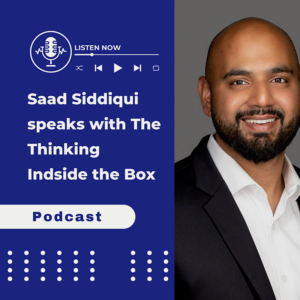In today’s episode, I chat with Saad Siddiqui, a General Partner at Titanium Ventures, a San Francisco-based VC firm that incorporates data science and quantitative analysis of non-financial data into its diverse investing criteria.
Saad started his career as an investment banker at RBC Capital Markets and Bank of America Merrill Lynch and previously served as an executive at Informatica and Cisco. Today, alongside his work at Titanium, SADZ is also an investor in HR tech companies like Certain, Specket and Forage, which makes a particularly interesting person to speak with about a number of topics that we’re passionate about here on the show.
From remote hybrid and fluid work to the latest HR tech trends, to what’s on the mind of business executives today considering their own digital transformations. Saad has a wealth of experience that’s on full display in this conversation.
We also chatted about the role of technology in fueling fluidity, how data affords leaders and organizations alike visibility and how he spots today’s startups in the HR technology space worthy of investment.
What kind of things are you hearing and seeing from the broader market?
The way I see it from a HR practitioner point of view, a lot of the technologies, a lot of the innovation, a lot of the concepts that are coming out today usually begin much early on into the world of venture capital.
Someone has a great idea, someone needs funding, needs access to network resources to bring their idea to market. And there’s been an absolute explosion of HR technology and data organizations that have entered the market over the last five years, certainly.
Trying to do that in a remote way, how to build culture, how to maintain culture, how to see if people are productivity skyrocketed, managing burnout to now kind of reopening the workplace and people trying to figure out, what is the best way for their workforce and their company to now manage going through an economic downturn?
So we’re starting to see a lot of headlines around layoffs and some of the most iconic companies having layoffs, some of which for the first time ever. HR professionals have been whipsawed in terms of growth at all costs and maintaining culture and hiring all these people to now managing remote work and managing the workforce and keeping morale high.
The Evolution of HR Technology and the “Fluid Workforce”
Our answer to this is the concept of fluidity. The fluid workforce, or identifying the right talent and training them in the most appropriate ways, to be more precise. If you can work wherever you want, you can work whatever hours you want.
Nowadays you need analytics to make sure that you’re hiring the right people, they’re productive, they’re incentivized in the right way so that it has impacts on benefits and the culture that you’re setting.
Everything needs to align with the employee, and sort of like making sure that they’re empowered, rather than everyone sort of fitting in a very neat box of a nine to five role that does a specific function.
As we transition towards an economic downturn, people will be asked to do more. With fewer resources, and more responsibilities, either we push to managerial roles, or if they were an individual contributor, learning new skills. This is also all part of fluidity and the fluid workforce.
In the world of startups, everyone’s doing kind of everything. You’ve got your main functions, but at the same time, you’re asked to step up in a bigger way and try to put your hands in a lot of different things.
These startups are disrupting larger corporations in a massive way. Naturally, they want to replicate some of that culture; making sure that people are given the flexibility that they need to step up in any way that they want.
Thus, systems need to allow for faster insights. They need to allow for quick responses and then try to understand what are the needs of the business. Finding the best people to address those needs in the fastest way possible.
That can only be done through newer systems that can help you identify the right talent, figuring out the teams that can go after some of these challenges. When talking about technology driving fluidity, data drives visibility, which was also sorely lacking in the HR systems of previous eras.
The importance of data can just simply not be understated when you’re talking about some of the big issues that organizations are struggling with. Those issues being: how do you identify, develop, and then ultimately retain top talent?
Data, Analytics, and HR Technologies
The major trend in data has been identifying the key metrics, but at the same time tracking almost everything because you never know what you might find better insights in. Over time more innovation is likely to happen using artificial intelligence and thus these systems become recommendation engines. This will help guide users into the best decisions to be made.
Those recommendation engines are now being used on the recruiting side. Over time, it’s likely going to start happening on the team building side, helping us figure out who the best folks on your team are to take on some of the most critical tasks of a company.
However, no one is purporting this data and technology as meant to solve all of the world’s problems. If anything, it helps focus your attention on the critical few problems and provide another source of data, input, or context. Which can be used to allow you to make better decisions when paired with traditional human or gut instinct, or even experiences and background.
However, as we’ve migrated to a more knowledge-based economy, Intellectual curiosity is absolutely critical. We’re in a place now where it’s no longer expected that you should know everything when you start a new role.
As these technologies become more sophisticated, people need to shift their reference point from the technology. Technology isn’t the replacement or the solution, but it’s merely a vehicle that’s meant for us to be able to achieve more, pairing our own inherent human qualities with tool sets that allow us to do better work in a world that’s becoming increasingly complex.
Over time the mode of technology tends to erode, but it needs to be deep enough that it’s not necessarily easy to replicate.
Is this something unique for people to either upend their systems or add a new tool to their basket? Something can’t be a 10% incremental improvement or 10% cost savings. It has to be significantly more or a newer way of doing things.
It’s more likely that an organization developing a single solution and keeping a narrow focus is going to have more longevity in the marketplace. Those organizations would be naturally incentivized to, for example, look at things like open APIs and build solutions with that cohesion in mind. That’s a significant trend of technology needing to fit a purpose and a good example of how we’ve evolved our thinking in the broader technology landscape. We now focus on what the best solution is for the end user and focus less on consolidating our own gains for the larger providers in the market.
These systems need to be modular in nature and offer open APIs. The bar’s really high, you need to do something very differentiated.

